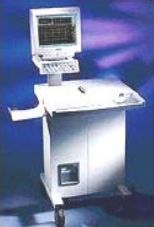GE
AMERICA North (USA-Canada-Mexico)
GE Marquette Stress System
Model: Case 8000
The CASE 8000 System for Exercise is one of the first, true point-of-care clinical information systems for the exercise environment. By combining the accuracy of their premiere exercise ECG system with the information accessibility of network connectivity, the CASE 8000 offers an advanced, integrated approach to high-efficiency, high-performance stress testing.
Exercise ECG Innovation
The CASE 8000 system builds on GE Marquette Medical System's tradition of ECG leadership, introducing new exercise testing capabilities that extend their distinguished history in signal…
System for Exercise is one of the first, true point-of-care clinical information systems for the exercise environment. By combining the accuracy of their premiere exercise ECG system with the information accessibility of network connectivity, the CASE 8000 offers an advanced, integrated approach to high-efficiency, high-performance stress testing.
Exercise ECG Innovation
The CASE 8000 system builds on GE Marquette Medical System's tradition of ECG leadership, introducing new exercise testing capabilities that extend their distinguished history in signal processing, microelectronics and ECG algorithms.
Performance Specifications
Instrument Type
Unity®-enhanced cardiac stress testing system with 14 channel acquisition and programmable lead configurations. Pentium-based, NT technology platform and hard drive storage deliver local and MUSE® database access.
Signal Processing
ECG analysis frequency: 500 Hz
ST measurements: ST amplitudes, slope, integral, index, ST/HR slope, ST/HR loops, ST/HR index up to 15 leads
E, J and post-J point: Manual or computer selected
Signal processing technique: Incremental median updating
Baseline correction: Cubic spline or Finite Residual Filter (FRF) algorithm
QRS detection and analysis: Based on automatic or manual lead selection
ECG output: Real-time ECG/QRS beep/TTL synchronization output
Heart rate: Automatic arrhythmia detection, documentation and annotation
Full disclosure ECG: Beat-to-beat ECG record and event review
Reanalysis: Post-test medians re-measurement from E, J, post-J point selections
ECG interpretation: (Optional) 12SL adult and pediatric ECG analysis program
Additional ECG function: Vectorcardiography
Data Acquisition
Technology: Active, "Type BF" floating isolated powered 14 channel acquisition module with built-in lead-fail detection and lead prep impedance measurement
Sampling rate: Over-sampling @ 4000 Hz, 12 leads
Dynamic range: 320 mV, ± 10 mV signal superimposed on ±150 mV DC offset
Resolution: 4.88 µV/LSB @ 500 Hz Noise: 140 dB (123 dB with AC filter disabled)
Input impedance: > 10 M Ohm @ 10 Hz, defibrillator protected
Patient leakage: < 10 µA Pace detect: Orthogonal LA, LL and V6; 750 µV @ 50 µs
Communications/Storage
MUSE® CV system compatible via diskette, network (optional) or modem (optional)
MUSE CV Web compatible for retrieval view and printing of MUSE CV system data
Remote view (optional) of real-time stress test at remote location
Local storage: Minimum 3.2 Gb hard drive storage of complete ECG record and test results
Local network storage (optional)
Display
Display type: High-resolution, color 0.25 mm dot pitch raster-written CRT
Display resolution: 1024 x 768 x 70 Hz refresh
Display size: 15* (standard) or 17* (optional) diagonal SVGA
Monitored leads: 3, 6 or 12
Displayed leads: Number on screen 3 or 6 (12 lead check)
Display format: 3 rhythm, 3 rhythm + medians, 3 rhythm + trends, 6 rhythm, 4 x 2.5 + 1 rhythm, 2x6
Display speeds: 25, 50 mm/s
Display sensitivity/gain: 2.5, 5, 10, 20 mm/mV
Displayed vital signs data (configurable): Heart rate, target heart rate, blood pressure, exercise clock, stage clock, phase clock, protocol, speed, grade, Watts, METS, RPP, and SpO2
Displayed data: ST scan/median complexes, arrhythmia's, ventricular ectopic/min counter, 3 to 15 waveforms, lead check torso and 12 leads, waterfall display, trends, tabular summary, stored ECG strips, interpretation, time-of-day clock, patient name, warning messages and prompts
Writer
Writer technology: "Instant" load, thermal dot array
Writer leads: 3, 6, 12 or 15 leads (standard, NEHB, Cabrera, configurable)
Writer speeds: 5, 12.5, 25 and 50 mm/sec (± 2%)
Writer sensitivity/gain: 2.5, 5, 10 or 20 mm/mV (± 5%)
Writer resolution: Horizontal 1000 lines/sec x 200 dpi dedicated local printing. 200 x 200 dpi generic printing
Paper type: Thermal, perforated, fan fold, 300 sheets/pack
Paper size: A size 214.63 x 280 mm (8.45 x 11 in) A4 size 210 x 297.5 mm (8.27 x 11.7 in)
Environmental Specifications
Power Requirements
Power supply: AC operation only
Operating voltage range: 90-135 VAC, 45-63 Hz, 2.8 A
180-270 VAC,
45-63 Hz, 1.4 A
Power consumption: 350 W max
(1200 BTU/Hr)

